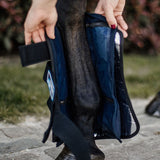Different Types of Boots for Horses
Posted on August 23 2021

There are several different types of boots for horses. The best boots for you will depend on factors such as your horse’s movement and the nature of work they are performing.
There are also several types of boots designed to protect your horse outside of work including therapy boots, travel boots and turnout boots.
Brushing Boots

Brushing boots are your staple exercise boot and the most widely used type of boot for horses. They are designed to protect your horse’s splint bone and fetlock from knocks and scrapes during movement.
Brushing boots are mainly used for flatwork but can also be useful for turnout. They may also be used for jumping at a low level.
Brushing boots have the same basic shape for both front and hind legs. They consist of a flat panel that protects the splint bone, wrapping around the leg to be secured with Velcro straps. Generally, brushing boots come in a run of sizes and most horses will take one size larger for the hind leg. More premium brands make a custom hind boot in each size.
There is a wide range of brushing boots available, the best boot for you will depend on usage and budget. If you expect your horse to wear their boots all day (for turnout) or for long schooling sessions in the summer, then a breathable brushing boot is preferable. For sensitive horses or a more aesthetic look, you may wish to opt for a fleece-lined brushing boot.
- SHOP BRUSHING BOOTS -
Jumping Boots
There are two types of jumping boots for horses; tendon boots for the front legs and fetlock boots for the hind legs. These are designed to offer a high level of protection without restricting movement.
Tendon Boots

Tendon boots protect the front tendon (which runs down the back of the leg) from high force knocks that may be incurred from the hind feet when jumping. In order to achieve this, they are formed of a semi-rigid mould that encases the leg from behind, protecting the tendons as well as the splint bone and fetlock.
Tendon boots are open-fronted, meaning that the boot does not wrap around the whole limb. Entry-level tendon boots have wide Velcro straps, more specialist boots use the elastic pin-hook closure which is designed to pivot for a better fit.
The best tendon boots will have a flexible, splinter-proof shell, be extremely strong and very lightweight. The top-end boots often use gel and/or carbon fibre materials for extra protection.
We only stock tendon boots from specialist jumping boot manufacturers. While these brands are premium options, their basic ranges are affordable and we would choose to use these over cheap copycats of more technical boots.
- SHOP TENDON BOOTS -
Fetlock Boots

Fetlock boots are essentially short brushing boots designed with a more specialist fit and greater strength. They protect the hind fetlock from high force knocks from the opposite hoof whilst jumping.
Fetlock boots are available in a wide range of designs. At entry-level they are made of a simple hard shell and wide Velcro strap, these are perfect if you are jumping at a low level or if you would like something more affordable for use at home. If you wish to affiliate with the British Showjumping Association, a ‘Young Horse boot’ is your best choice as these are the only fetlock boots permitted for junior, amateur and young horse age classes.
Technical fetlock boots provide more coverage and use the elastic pin-hook closure. Beyond that, there are also professional fetlock boots that encase the back of the fetlock with an active fit to encourage jump action, these should only be used by experienced riders.
- SHOP FETLOCK BOOTS -
Overreach Boots AKA Bell Boots

Overreach boots have a bell shape (hence often being called bell boots) and fit around the front pastern to cover the heel. They are designed primarily to protect from overreach injury (when the hind foot treads on the heel causing bruising and laceration) but they can also be useful to reduce shoe loss both in work and in the field.
More overreach boots are sold than any other type of boot as they are used across all disciplines and in turnout. They also take quite a battering, so you should expect to have to replace these much more often than other types of boots for horses.
The most common overreach design is still a simple bell shape, usually formed of neoprene which is generally safer (because it does not stretch), more comfortable and more protective than rubber. More specialist jumping boots have an ergonomic shape designed to fit closely to the hoof, provide extra protection and minimise the potential for jump interference or tripping.
- SHOP OVERREACH BOOTS -
Cross Country Boots

Cross country boots, also called event boots or XC boots, are similar to brushing boots but provide a higher level of protection, usually incorporating front tendon protection, for use during the cross country phase.
The best cross country boots should have an excellent fit to prevent slipping and spinning. They will have additional protection for the structures of the horse’s limb and a tough outer that is able to tolerate fence impacts. They should also be lightweight and highly water repellent so that they do not absorb water and become heavy.
Expect the top end cross country boots to come with quite a punchy price tag. Generally speaking, we find that they are worth it due to the technicality, fit and durability required. You can purchase copycats but there is a clear difference in quality and performance.
- SHOP CROSS COUNTRY BOOTS -
Turnout Boots for Horses
Turnout boots is a generic term for any boot that may be useful for turning out. It will often be used simply to describe a brushing boot that is well suited to the field; something lightweight, breathable and mud repellent. Our favourite is the Kentucky 3D Spacer, or for something more economical we don’t think you can beat the Woof Double Lock Brushing Boots.
Turnout boots may also describe a particular type of boot that is a tight-fitting, stretchy layer designed to help protect your horse in the field. In summer, turnout boots may be used to protect against knocks as horses kick at flies.
Many people use turnout boots designed to protect against mud fever like the Woof Wear Mud Fever Turnout Boot. These need to be tight fitting around the hoof to create a good seal that keeps mud away from the heel and pastern area, but should be as breathable as possible. Keeping your horse’s legs dry and minimising contact with mud will greatly reduce skin irritation caused by bacteria that thrive in wet, muddy conditions.
- SHOP TURNOUT BOOTS -
Pastern Wraps

Pastern wraps are an easy and economical way to help protect close moving horses that tend to knock the pastern area. We often turn out in them in summer when our horses are stamping at flies.
Pastern wraps can be used on their own, with a brushing boot or with a tendon boot. If you are already using an overreach boot then a pastern wrap should not be needed. Choosing an overreach boot with a sheepskin collar will provide more protection for the pastern area if your horse needs it.
- SHOP PASTERN WRAPS -
Therapy Boots - Ice Boots

Ice boots allow you to apply cold therapy to your horse’s limb without being tied to a cold hose.
Icing plays an important role in recovery from both injury and strenuous exercise. Ideally, it should be used for twenty minutes (with repeated cycles if necessary) immediately post-exercise or injury to help reduce inflammation and manage pain.
Recent research has shown that covering the horse’s limb during strenuous exercise (even when using the most ‘cooling’ boots) can cause damaging levels of heat to accumulate in the tendons. It is best to remove your horse’s boots as soon as you finish your session and apply some form of cooling.
Some of the cold packs used in ice boots can also be used for heat therapy. Alternating between cold and warm therapy can be useful for some sports recovery. Warming can also be useful before exercise, particularly in cold weather, for injury prevention and comfort for arthritic horses.
Therapy Boots - Magnetic & Other

Magnetic therapy has long been used as a complementary therapy to aid circulation, recovery and mobility. In order for magnetic boots and bands to be effective, they should be placed over (or in close proximity to) the area in need of treatment. Magnetic boots vary a great deal in price, ranging from an economical pastern wrap to more technical stable boots and hock boots.
There are a number of alternative therapy products now also available which claim similar benefits to magnetic therapy. Of these, we think the best comes from Incrediwear Equine who supply socks and bandages that promote circulation and drainage and can also be used wet for icing.
- SHOP THERAPY BOOTS FOR HORSES -
Travel Boots

Travel boots are large boots that cover from the knee or hock, right to the floor and are designed to protect your horse during travel. They have the advantage of being easy to use and providing full coverage. Travel boots are particularly useful if you are not confident bandaging your horse’s legs. They also incorporate hock and knee protection which standard bandaging does not.
Generally, most competition owners would still use a stable pad and bandage for travelling as they will provide a better fit and also support the limb.
- SHOP TRAVEL BOOTS & BANDAGES -


